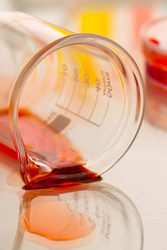Don't Panic! A Guide to Handling Chemical Spills Safely and Effectively
28th Feb 2024
Working in a laboratory or industrial setting often involves handling chemicals. While these chemicals are essential for research and various processes, spills can happen. Knowing how to respond quickly and safely to a chemical spill is crucial to minimize risks and prevent injuries.
This blog post outlines the essential steps for handling a chemical spill, ensuring the safety of yourself, others, and the environment. Remember, safety always comes first. If you're unsure about any aspect of the spill or your ability to handle it safely, evacuate the area immediately and call for help.
Step 1: Assess the Situation
The first moments after a chemical spill are critical. Here's what you need to do:
- Identify the Spilled Chemical: If possible, safely identify the chemical involved. Look for container labels or Safety Data Sheet (SDS) information in the vicinity. Knowing the chemical's properties will guide your response.
- Evaluate the Threat: Consider the size of the spill, the chemical's hazard class (flammable, corrosive, toxic, etc.), and its potential for environmental contamination.
- Assess Injuries: Check yourself and others in the immediate area for any injuries caused by the spill. If there are injuries, prioritize medical attention before attempting cleanup.
Step 2: Evacuate and Contain the Spill
- Evacuate the Area: If the spill is large, poses an immediate threat, or the chemical is unknown, evacuate the area immediately. Close doors behind you to prevent the fumes from spreading.
- Alert Others: Inform those nearby about the spill and the evacuation. If necessary, activate building alarms to alert emergency personnel.
- Contain the Spill (if safe to do so): If the spill is small and you have the proper training and equipment, attempt to contain it. Use spill kits containing absorbent materials like pads or socks to create a barrier around the spill, preventing it from spreading further.
Important Note: Never attempt to contain a spill if it involves a highly flammable, reactive, or toxic chemical, or if you lack the appropriate training and personal protective equipment (PPE).
Step 3: Personal Protective Equipment (PPE)
Once the area is evacuated or the spill is contained, you can proceed with cleanup, but only if you have the necessary PPE. PPE selection depends on the specific chemical involved. Here's a general guideline:
- Safety Glasses or Goggles: Protect your eyes from splashes and fumes.
- Chemical-Resistant Gloves: Wear gloves made from a material compatible with the spilled chemical to prevent skin contact.
- Lab Coat or Apron: Wear protective clothing to shield your skin and clothes from contamination.
- Respiratory Protection: If the spill generates harmful vapors or dust, wear a respirator with the appropriate filter for the specific chemical.
Never attempt a cleanup without proper PPE. If you lack the necessary equipment, wait for emergency responders.
Step 4: Cleanup Procedures
- Neutralize the Spill (if applicable): For certain spills, like acid or base spills, neutralization may be necessary. Refer to the SDS for specific neutralization procedures.
- Absorb the Spill: Using spill pads or socks from a spill kit, carefully absorb the spilled chemical. Work from the outside of the spill inwards to prevent further spreading.
- Decontaminate the Area: Once the spill is absorbed, decontaminate the affected area following the SDS recommendations. This may involve using specific cleaning solutions or wipes.
Remember: Dispose of all contaminated materials, including used PPE and absorbent pads, according to the regulations for hazardous waste disposal.
Step 5: Report the Spill
Even for minor spills, it's crucial to report the incident. Here's who to inform:
- Supervisor or Safety Officer: Report the spill to your supervisor or designated safety officer within your organization. They will assess the situation and determine if further action is required.
- Emergency Responders (if necessary): For large spills, spills involving hazardous materials, or any spill you're unsure about handling, call emergency services immediately.
Additional Tips for Safe Chemical Handling:
- Familiarize Yourself with Safety Procedures: Before working with any chemicals, thoroughly review the SDS and understand the associated hazards.
- Maintain a Clean and Organized Lab: A cluttered workspace increases the risk of spills. Keep your work area clean and organized, and properly store chemicals following recommended guidelines.
- Regular Inspections: Conduct regular inspections of your workspace and equipment to identify potential hazards and leaks.
- Spill Kits Readily Available: Ensure spill kits are readily available in designated locations throughout the lab or workplace.
By following these steps and prioritizing safety, you can effectively handle chemical spills and minimize the risk of injuries and environmental contamination.
Contact us today to learn more about how we can help you achieve your healthcare supply chain goals.
(732) 447-1100 // info@cenmed.com

